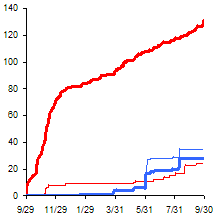

Media Report Card
Off the Charts
Accuracy in Reporting of Israel/Palestine
The New York Times
Study Periods:
September 29, 2000 - September 28, 2001
January 1, 2004 - December 31, 2004
|
|
Download Report
Press Release
Meeting with NY Times
Abstract
This study consists of a statistical examination of The New York Times’ news coverage of the first year of the current Palestinian uprising, and of its coverage of that uprising in 2004. The categories examined are coverage in headlines or first paragraphs of conflict deaths and, as a subcategory, children’s deaths. In addition, we studied coverage of deaths in complete articles for a sample month-long sub-study in 2004. Our findings indicate significantly distorted coverage by The New York Times of these topics. In the first study period The Times reported Israeli deaths at a rate 2.8 times higher than Palestinian deaths, and in 2004 this rate increased by almost 30%, to 3.6, widening still further the disparity in coverage. The Times’ coverage of children’s deaths was even more skewed. In the first year of the current uprising, Israeli children’s deaths were reported at 6.8 times the rate of Palestinian children’s deaths. In 2004 this differential also increased, with deaths of Israeli children covered at a rate 7.3 times greater than the deaths of Palestinian children. Given that in 2004 22 times more Palestinian children were killed than Israeli children, this category holds particular importance. We could find no basis on which to justify this inequality in coverage.
Introduction
Beginning in 2003, If Americans Knew1 began issuing report cards to media across the country on their coverage of the Israeli-Palestinian conflict. This study of The New York Times covers the first year of the current uprising (September 29, 2000 through September 28, 2001). This period was selected for study because it set the context within which all subsequent reporting on the conflict is viewed. We also studied The Times’ coverage for 2004 to discover whether the patterns we found for the first year had continued, diminished, or increased.
Given that the media have a desire and a responsibility to cover this topic accurately, we provide these reports in the hope that our analyses can assist them in achieving this goal.
In addition, we are making these reports public, as a way to help readers evaluate for themselves the reliability of their sources of information on this issue.
The goal of this report is to
- Establish clear standards for assessing accuracy in reporting.
- Provide, in a consistent format, an assessment of the media’s accuracy in reporting on the Israel/Palestine conflict.
Methodology
We recognize that reporting on Israel/Palestine has been an exceptionally controversial topic. Therefore, while there are many potential yardsticks for measuring accuracy, we chose criteria that would be widely acknowledged as significant, conducive to statistical analysis, and immune to subjective interpretation.
This study of The New York Times roughly follows the conventions of our previous studies. Our decision to look at only headlines and first paragraphs was motivated by the goal of assessing the average reader’s experience and the prominence given to the coverage. In addition, we conducted a sub-study of full articles in one month-long period.
We chose to focus on the reporting of deaths, because this allows meaningful statistical analysis that would be impossible in a qualitative study. This unambiguous yardstick allows us to determine whether The New York Times demonstrates even-handed respect for human life, regardless of ethnic or religious background. Fortunately, accurate data for both populations is available from the widely respected Israeli human rights organization, B’Tselem2. We only included Israeli deaths directly caused by the actions of Palestinians, and vice-versa.
Children’s deaths were studied because each such event represents a universally recognized human tragedy. We separately kept track of reports of cumulative death counts. We used the LexisNexis database to access all Foreign Desk articles published during our study periods. We did not include editorials, columns, news briefs, letters to the editor, etc. in our study.
Findings
I. Coverage of All Deaths: First Year of the Current Uprising
We found a significant disparity in the likelihood of a death receiving coverage based on the ethnicity of the person killed.
For the first year of the current uprising, there were 197 reports in New York Times headlines or first paragraphs of Israeli deaths. During this time, there had actually been 165 Israelis killed (the discrepancy is due to the fact that a number of Israeli deaths were reported multiple times).
During the same year-long period, 233 Palestinian deaths were reported in headlines or first paragraphs. During this time, 549 Palestinians had actually been killed.3

|
In other words, 119% of Israeli deaths and only 42% of Palestinian deaths were reported in New York Times headlines or first paragraphs.
That is, The Times reported prominently on Israeli deaths at a rate 2.8 times greater than Palestinian deaths.

|
Finally, we compared the running totals of actual and reported deaths for Palestinians and Israelis. This finding underscores The Times’ tendency to report a fictional situation in which Israeli and Palestinian deaths occur at more or less the same rate, and illustrates the dramatic gap between the reality of Palestinian fatalities and the coverage of them.

|
It is significant to note that The Times reported Palestinian deaths along a curve that largely replicated the Israeli death count, despite the fact that the curve for actual Palestinian deaths was both considerably different and far higher than the Israeli curve. At the same time, part way through the year the running total of Israeli deaths reported by The Times rose above the actual number of deaths. Such reporting gives readers a substantially incorrect impression of the conflict.
II. Coverage of All Deaths: 2004
In studying The Times’ 2004 coverage, we found that this pattern of distortion continued and, in fact, worsened.
In 2004, there were 159 reports in New York Times headlines or first paragraphs on Israeli deaths. During this time, there had actually been 107 Israelis killed (the discrepancy is due to the fact that a number of Israeli deaths were reported multiple times).
During the same one-year period, 334 Palestinian deaths were reported in headlines or first paragraphs, while 818 Palestinians had actually been killed.4

|
Put another way, 149% of Israeli deaths and only 41% of Palestinian deaths were reported in New York Times headlines or first paragraphs.
The Times reported on Israeli deaths at a rate 3.6 times greater than it reported on Palestinian deaths, up 29% from 2.8 in the first year. Thus, The Times’ distortion grew even more pronounced in its more recent coverage of the conflict.
In reality, 7.6 times more Palestinians were killed than Israelis in 2004.

|
Comparing the running total of reported deaths versus actual deaths for both populations, we again found significant differentiation in reporting on the two groups:
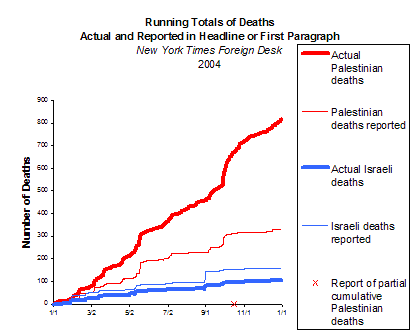
|
III. Coverage of Children’s Deaths: First Year of Current Uprising
For the first year of the current uprising, 35 Israeli children’s deaths were reported in the headlines or first paragraphs of New York Times articles on the Israel/Palestine conflict, compared with 24 Palestinian children’s deaths. (Children are defined by international law as those who are 17 and younger.)
According to B’Tselem, during this time there were 28 Israeli and 131 Palestinian children killed.5 Thus, Palestinian children were killed at a rate 4.7 times greater than Israeli children.
Additionally, Palestinian children made up a disproportionately large number of Palestinian deaths in general. Children’s deaths accounted for 24% of the Palestinians killed, while children’s deaths accounted for 17% of Israelis killed during this period.
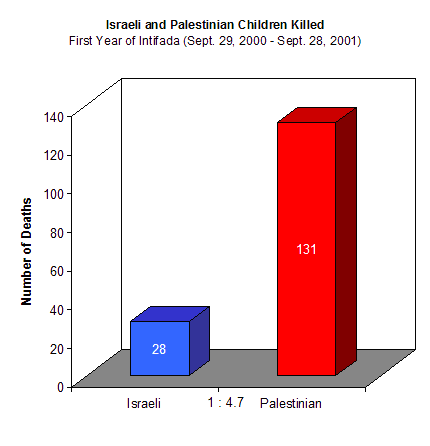
|
To understand the pattern of The Times reporting on children’s deaths, it is useful to compare the number of deaths reported in headlines or first paragraphs to the number of deaths omitted, for Israelis and Palestinians respectively:
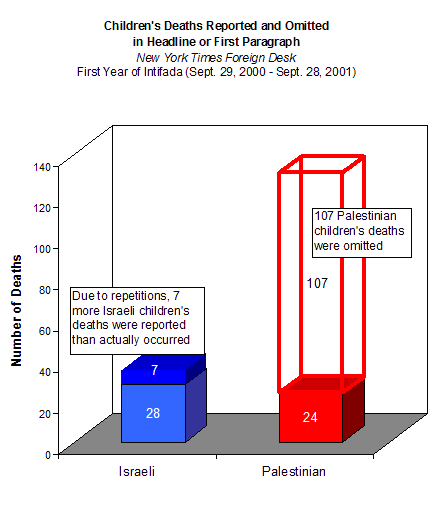
|
In other words, 125% of Israeli children’s deaths and only 18% of Palestinian children’s deaths were reported by The New York Times in headlines or first paragraphs.
That is, The Times reported prominently on Israeli children’s deaths at a rate 6.8 times greater than Palestinian children’s deaths.
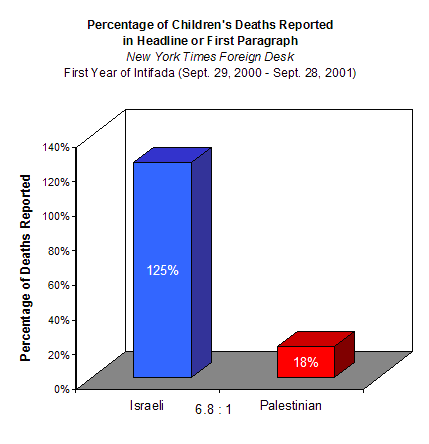
|
Again, we graphed the running totals of actual and reported deaths for Palestinians and Israelis. Similar to its treatment of deaths in general, The Times vastly underreported killings of Palestinian children and inflated those of Israeli children.
In addition, it is important to note the sequence of deaths, and The Times’ failure to report this chronology adequately. While at least 826 Palestinian children were killed before the first Israeli child’s death, only 9 of these Palestinian children’s deaths were reported in The Times headlines or first paragraphs.
It is significant to compare the curves of The Times’ coverage of deaths. In doing this, we discover the newspaper reported both death rates almost identically. In fact, as the year went on, the number of prominent mentions of Israeli children’s deaths exceeded the actual number of deaths (due to repetitions in coverage), while The Times reported fewer Palestinian children’s deaths than Israeli deaths – despite the fact that almost five times more Palestinian children were actually being killed than Israeli children.
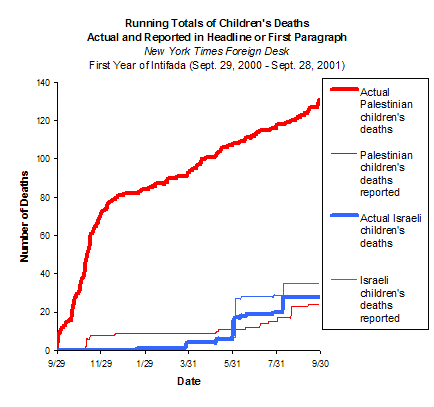
|
Finally, we see that while the death of an Israeli child was prioritized above the killing of an adult (125% of Israeli children’s deaths were reported compared to 119% of Israeli deaths in general), the killing of a Palestinian child was de-prioritized (18% of children’s deaths compared to 42% of deaths in general). This occurred despite the abnormally high proportion that Palestinian children made up of Palestinian casualties. One might expect the fact that Palestinian children constituted such a high percentage of deaths to have been considered newsworthy in itself, not the reverse.
IV. Coverage of Children’s Deaths: 2004
In 2004, we find the disparity of reporting on Israeli and Palestinian children’s deaths even greater than in the coverage of the first year. In 2004, 4 out of 8 Israeli children’s deaths were reported. During the same period only 12 out of 176 Palestinian children’s deaths were reported.
Again, Palestinian children were making up a much greater part of the total number of Palestinians killed than Israeli children were of Israeli conflict casualties. Children’s deaths accounted for 21.5% of the Palestinians killed, while children’s deaths accounted for only 7.5% of Israelis killed during this period.
During 2004, 22 times more Palestinian children were killed than Israeli children.
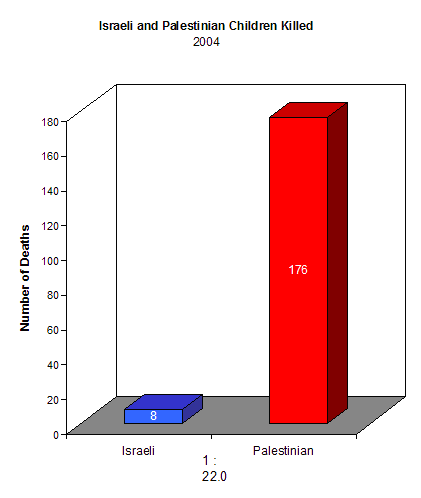
|
During this period, The Times reported on 50% of Israeli children’s deaths in headlines or first paragraphs, while reporting on only 7% of Palestinian children’s deaths.

|
One of the most disturbing findings of this report is that the inequality in coverage of children’s deaths found during the first study period grew markedly worse in 2004. During this year, The Times reported on Israeli children’s deaths at a rate 7.3 times greater than Palestinian children’s deaths. In other words, the already large emphasis on Israeli deaths over Palestinian deaths grew even larger.
Visual representation of this pattern of omission gives a sense of the enormity of the disparity.

|
Comparing running totals for actual deaths and reported deaths once again reveals that The Times’ reporting on Palestinian children’s deaths followed virtually the same line as Israeli children’s deaths, in stark contradiction to the reality, in which Palestinian children were being killed at a rate 22 times greater than Israeli children.

|
V. Coverage of Deaths in Full articles: 2004
In order to determine whether the patterns found in the above studies of headlines and first paragraphs are amplified or diminished when a larger portion of the article is examined, we did a study of full articles of an arbitrary month-long period in 2004.
From June 28 to July 27 seven Israelis were killed, including one child. 60 Palestinians were killed by Israelis, roughly 8.6 times the number of Israelis killed by Palestinians. 18 Palestinian children were killed. Hence, this month-long study period was roughly representative of 2004 in general, in which Palestinian deaths outnumbered Israeli deaths by a factor of about 7.6 and Palestinian children were being killed at a rate approximately 22 times that of Israeli children.
In the headline and first paragraph of articles printed in this study period, there were mentions of seven Israeli deaths, including one child’s – 100% of the deaths that occurred during this period; 33% of Palestinian deaths were reported, and 11% of Palestinian children’s deaths.
In other words, Israeli deaths were covered in headlines or first paragraphs at a rate three times greater than Palestinian deaths. Israeli children’s deaths were covered in headlines or first paragraphs at a rate nine times greater than Palestinian children’s deaths.
In this sub-study we looked further into the articles, and recorded the first paragraph in which a death was mentioned. Thus, if a person’s death was reported in the fourth, fifth, and sixth paragraphs, we counted it as appearing in the fourth paragraph. Although repetitions within articles were not counted, we did count repetitions in different articles, e.g. if a death was mentioned in one article in a headline and then in a later article in the fifth paragraph, we counted both of these occurrences.
First Five Paragraphs:
In the first five paragraphs and headlines, 157% of Israeli deaths and 200% of Israeli children’s death were reported. There were no additional mentions of Palestinian deaths, so coverage of Palestinian deaths stayed at 33%. One article mentioned in the second paragraph that one of the previously mentioned deaths was of a child, increasing the percent of Palestinian children’s deaths covered to 17%. Hence, the ratio of Israeli to Palestinian deaths covered grew from 3 to 4.7, and for children’s deaths it grew from 9 to 12.
Full Articles:
Expanding to an examination of the full articles, we find that Israeli deaths had been covered slightly more disproportionately than they were in the headlines and first paragraphs. Here, Israeli deaths were covered at a rate 3.1 times greater than Palestinian deaths (257% of Israeli compared to 82% of Palestinian) compared to a ratio of 3.0 in headlines/first paragraphs. Again, the distortion was even greater in coverage of children’s fatalities. Israeli children’s deaths were covered at a rate 10.3 times that of Palestinian children (400% of Israeli and 39% of Palestinian) up slightly from 9 times greater in headlines and lead paragraphs.
In other words, emphasis on Israeli deaths over Palestinian deaths, found in the above studies of headlines and lead paragraphs, persisted (largely through repetitions of previously reported Israeli deaths) when the entire article was examined.

|

|
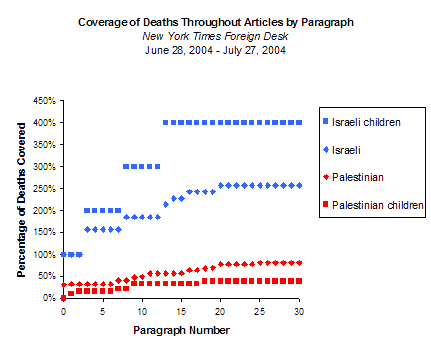
|
Interestingly, a closer examination shows that every death mentioned solely in the last two paragraphs of an article was Palestinian. There were five Palestinian deaths mentioned for the first time in the second to last paragraph, including that of a 16-year-old girl shot through the chest by the Israeli army. Also, there were five Palestinian deaths mentioned for the first time in the last paragraph.
On July 6 an article was published with a lead paragraph that read “An Israeli Army officer and four Palestinians were killed in exchanges of fire early Tuesday around the Ain Beit Ilma refugee camp in the West Bank town of Nablus, Israeli and Palestinian security sources said.” The author devoted the rest of the article to details of the “exchange” and only mentioned that one of the Palestinian dead was a 15-year-old boy in the final paragraph.
Without these belated mentions, the percentage of Palestinian deaths covered drops to 65% (four times lower than Israeli deaths) and that of Palestinian children’s deaths drops to 28% (14.4 times lower than the corresponding Israeli number).
Since readership diminishes the further down an article one goes, such patterns reduce readers’ awareness of Palestinian deaths. In addition, The New York Times wire service provides its news stories to newspapers throughout the nation. When space limitations require that a story be cut, journalistic practice is to cut from the bottom. As a result, it can be expected that newspapers around the country omitted Palestinian deaths at an even greater rate than The New York Times.

|
VI. Coverage of Cumulative Totals
Regarding The Times coverage of cumulative totals, information that would have at least somewhat ameliorated the above misimpressions, we found that The Times’ headline and first paragraphs had never reported numbers for both populations side by side. (Cumulatives were defined as reports summarizing deaths over a period of time greater than one week.)
Once in 2004 it reported a partial cumulative figure of Palestinian deaths. Such a cumulative, however, without corresponding statistics for both populations, does little to enlighten readers on the comparative deaths among all people in the region.
In our month-long sub-study of full articles, The Times did mention full cumulative counts of fatalities for both populations side by side twice: once in paragraph 14 and once in paragraph 20.
Additional Notes
While gathering our data, we came across a number of additional patterns of distortion that merit further examination. In particular, there appeared to be considerable differentiation in the amount and type of contextual information regarding deaths, according to ethnicity of the victim. In addition, while Israeli deaths were often depicted as innocent victims of Palestinian aggression, Palestinian deaths were generally portrayed as a necessary result of conflict, the victims frequently identified as combatants.
Notably, almost all deaths resulting from so-called “clashes” were Palestinian, which suggests a more unilateral violence than the word is commonly understood to convey. Similarly, it appeared that while Israeli civilian deaths were emphasized, Palestinian civilian deaths were minimized, almost to the point of invisibility.
This type of reporting constitutes significant distortion of the reality of the conflict, in which civilians are being killed in great numbers on both sides, and the number of Palestinian civilian deaths is considerably greater than the number of Israeli ones.7
Conclusions
We are concerned about the results of this study. We believe the readers of The New York Times, as well as all Americans, are entitled to full and accurate reporting on all issues, including the topic of Israel/Palestine.
Given that The Times had ample coverage of this issue (well over 1000 stories), it is troubling that so much critical information for American readers was omitted. Further, our findings suggest a pattern of distortion in New York Times coverage of the Israeli-Palestinian conflict inconsistent with normal journalistic standards. Such a pattern of distortion, in which readers were given the impression that the Israeli death rate was greater than it was, and that the Palestinian death rate was considerably smaller than its reality, may serve to misinform readers rather than inform them.
In particular, our study showed immense distortion in the coverage of children’s deaths. By covering similar numbers of Israeli and Palestinian children’s deaths in headlines or first paragraphs, The Times suggested an equivalency in death rates for the two groups, when in actuality over eight and a half times more Palestinian children had been killed during these two study periods. (In fact, in 2004, 22 times more Palestinian children were killed than Israeli children.) Additionally, Times’ coverage obfuscated the fact that at least 82 Palestinian children were killed before the first Israeli child’s death.
Such coverage, in which similar numbers of Israeli and Palestinian deaths were given prominence, may give The Times readers an impression of balanced reporting that a careful examination of these two year-long periods does not justify.
We assume that The New York Times is as disturbed as we have been to find these shortfalls in its quest to provide excellent news reporting to its readers. Now that it has been alerted to these distortions in its Israel/Palestine coverage, we encourage The Times to undertake whatever changes are necessary to provide accurate news coverage of this vital issue.
Finally, in the interest of full and accurate reporting, we urge The Times to inform its readers of the findings of this study. In addition, we encourage The Times to report on the strategies it intends to use in remedying the significant flaws this study has shown of its coverage of the Israeli/Palestinian conflict.
Summary of Data
New York Times Foreign Desk |
||||
|
Israeli |
Palestinian |
Israeli Children |
Palestinian Children |
Actual Deaths |
165 |
549 |
28 |
131 |
Deaths Reported in Headline or First Paragraph |
197 |
233 |
35 |
24 |
Percentage Reported |
119% |
42% |
125% |
18% |
Ratio Israeli:Palestinian Deaths Reported |
2.8 : 1 |
6.8 : 1 |
||
|
||||
Actual Deaths |
107 |
818 |
8 |
176 |
Deaths Reported in Headline or First Paragraph |
159 |
334 |
4 |
12 |
Percentage Reported |
149% |
41% |
50% |
7% |
Ratio Israeli:Palestinian Deaths Reported |
3.6 : 1 |
7.3 : 1 |
|
|
Actual Deaths |
7 |
60 |
1 |
18 |
Deaths Reported in Headline or First Paragraph |
7 |
20 |
1 |
2 |
Percentage in Headline/First Paragraph |
100% |
33% |
100% |
11% |
Ratio Israeli:Palestinian Deaths Reported |
3.0 : 1 |
9.0 : 1 |
||
Deaths Reported in First Five Paragraphs |
11 |
20 |
2 |
3 |
Percentage Rep’d in First Five Paragraphs |
157% |
33% |
200% |
17% |
Ratio Israeli:Palestinian Deaths Reported |
4.7 : 1 |
12.0 : 1 |
||
Deaths Reported in Full Articles |
18 |
49 |
4 |
7 |
Percentage Rep’d in First Five Paragraphs |
257% |
82% |
400% |
39% |
Ratio Israeli:Palestinian Deaths Reported |
3.1 : 1 |
10.3 : 1 |
||
End Notes
- If Americans Knew is dedicated to providing full and accurate information to the American public on topics of importance that are underreported or misreported in the American media. Our primary area of focus at this time is Israel/Palestine. For more information contact us.
- For more information about this organization, visit their website at www.btselem.org.
- These numbers do not include Palestinians civilians who died as a result of inability to reach medical care due to Israeli road closures, curfews, etc. The figure for Palestinian deaths is extremely conservative, since it is difficult for B’Tselem to report on deaths in the Palestinian territories. Palestinian medical organizations report a higher number for this period. For example, the Palestine Red Crescent Society (www.palestinercs.org), internationally respected for its statistical rigor, reports that 693 Palestinians were killed during this time.
- For a number of reasons explained above, the Palestinian figure is extremely conservative. Palestinian medical organizations report a higher number for this period. For example, the Palestine Red Crescent Society (www.palestinercs.org) reports that 881 Palestinians were killed during this time.
- For a number of reasons explained above, the Palestinian figure is extremely conservative.
- Remember These Children places this number at 84, including two Palestinian children who died when Israeli forces blocked their access to medical care.
- B’Tselem, Palestine Monitor
| Media Report Cards |
Off the Charts: ABC, CBS, & NBC |
Off the Charts: New York Times |
| Related Organizations |
| Stay Informed |
|
Sign up for our mailing list and receive an email whenever we post a new article on our news site, Israel-Palestine News. |
This website is printer-friendly. Please Print this article and share it with your friends and family.


